Welcome to my dairy free weaning blog, where I will guide you through the journey of navigating dairy free weaning with a milk allergy.
Are you ready to conquer this challenge? I’ve got you covered! From discovering the best dairy-free alternatives to sharing recipes, I aim to provide you with valuable insights to ensure your child receives all the essential nutrients.
If your child has been diagnosed with a cow’s milk allergy, I understand the importance of having expert support during this process. That’s why I’m here to assist you every step of the way.
As an experienced dietitian, I offer professional guidance. Additionally, as a fellow mum who has survived living with a baby with a milk allergy, I can relate to the initial fears that accompany starting the weaning journey.
What is dairy free weaning?
Weaning (also known as complementary feeding) or starting solid food is required after 6 months old to meet your babies nutritional needs. (1) As after six months old, milk alone will not provide enough nutrition for your baby to grow and develop.
Dairy free weaning put simply is avoiding any food with cow’s milk in it. You still wean in the same way, weather is it is baby led, puree or a combination of both. However, it is important to make sure you are checking every label and not adding any milk products to your homecooked food.
You may be surprised to know that if we remove a food group, in this case dairy, you still need to make sure you replace any missing nutrients in your baby’s diet.
Check out my blog for help on starting weaning.
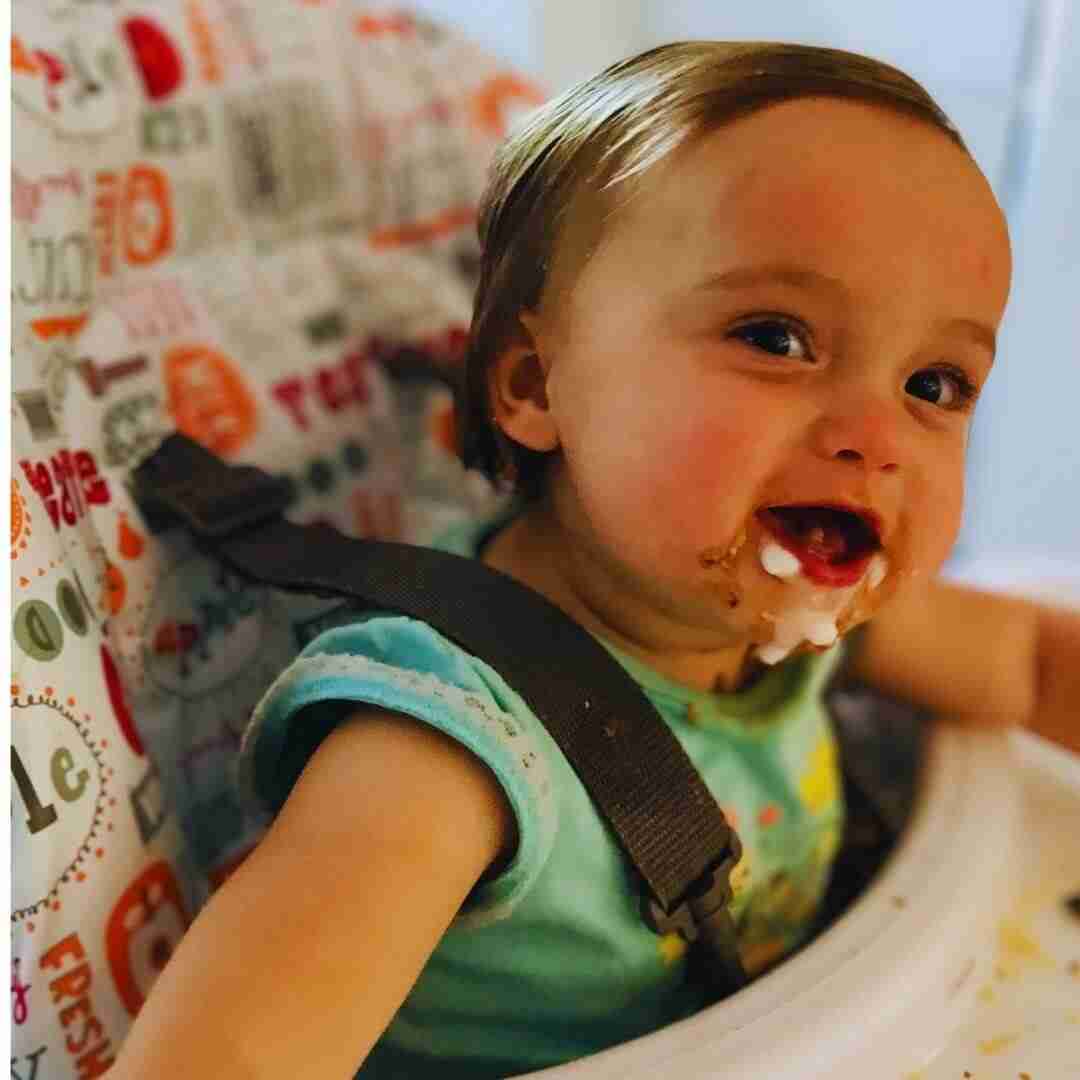
What is a Cow’s milk protein allergy? (CMPA)
Cow’s milk protein allergy (CMPA) is an abnormal response by the body’s immune system in which the proteins in cow’s milk are recognised as a potential threat. It is estimated to affect around 7% of babies under the age of one, although most children grow out of it by the age of five. (2)
For more information on a cow’s milk allergy check out my blog
The difference between CMPA and lactose intolerance
A cow’s milk allergy is different than lactose intolerance. Lactose intolerance occurs when the body produces little to no lactase, an enzyme which aids in the breakdown of the sugar, lactose, found in milk.
Symptoms of a lactose intolerance often include gastrointestinal issues such as diarrhoea, stomach pain, bloating, or gas.(3) Lactose intolerance is rare in babies.
What is the difference between a food allergy or intolerance?
Food allergies and intolerances may appear similarly, however, their mechanisms differ. Allergies are reactions of the immune system to foods or the environment. This is the body’s natural defence to keep us protected.
The immune system does not play a role in food intolerances.(3) Instead, food intolerances are a result of the body having a sensitivity to certain foods. Demonstrated by symptoms such as gas, diarrhoea, or abdominal pain/cramping.
Immediate/IgE mediated food allergy:
An immediate, IgE mediated allergic reaction occurs after consumption of the protein within the allergen food. The body reacts to this by releasing the chemical histamine, which may cause symptoms such as itching or swelling on the skin or vomiting and/or diarrhea. (3)
Specifically, in an IgE mediated cow’s milk allergy, symptoms may include an “itchy rash, redness or hives (nettle rash), swelling, runny nose, itchy eyes, coughing, vomiting, swallowing or breathing difficulties which are rare.” (3)
Delayed/Non-IgE mediated food allergy
A delayed, non-IgE mediated allergic reaction occurs after the consumption of certain foods. Gastrointestinal symptoms such as diarrhoea, constipation, vomiting, gas, bloating, nausea or abdominal pain or skin concerns like eczema may gradually arise.3,4
IMAGE on symptoms CMPA
Testing for a cow’s milk allergy
An allergist may be seen to test for a cow’s milk allergy. The tests used to diagnose IgE mediated (immediate) allergies include a skin prick test or a blood test to check for antibodies.
A non-Ige (delayed) mediated cow’s milk allergy is tested through eliminating cow’s milk protein to see if symptoms go away.5
Speak to your health professional or dietitian for more support.
Does my baby need to avoid all food with milk
The simple answer is yes. You need to avoid foods that contain cow’s milk or cow’s milk proteins. Fortunately, most babies can tolerate traces within food. However, it is important to first speak to your dietitian for further advice.
Check the labels
The following foods and ingredients can contain cow’s milk protein.
- Yoghurt and fromage frais
- Butter, buttermilk, butter oil, ghee and margarine
- Cheese, cheese powder
- Cow’s milk – including fresh and dried e.g. powdered milk
- Cream, sour cream, crème fraiche
- Ice cream
- Whey, hydrolysed whey powder, whey syrup sweetener
- Casein (curds), caseinates, hydrolysed casein, calcium caseinate, sodium caseinate 6
Add an image of a LABEL here
Breast Feeding and Formula Milk
If you are breastfeeding, you may need to eliminate cow’s milk from your breast milk as well. If your child is on formula, they may benefit by using a low allergen or hypoallergenic formula.
Due to the different taste and smell of hypoallergenic formula in comparison to the typical infant formula, it may be helpful to slowly introduce or combine it with their usual formula.
While hydrolyzed formulas contain cow’s milk protein, it is more tolerated because the proteins have been hydrolyzed into smaller pieces so they may not be as detectable to the immune system. If symptoms still occur on the hydrolyzed formula, an amino acid formula may be tolerated.
The amino acid formula does not contain cow’s milk and the protein is broken down fully. Seek support from a dietitian to help determine whether your child is tolerating their formula well and if it is the most suitable option for them.
But be prepared for the green poos on these formulas!
IMAGE on milks
Can’t they have plant milk instead?
Yes and No. After 6 months old your baby can have plant milk in food e.g. cereal, white sauces, prepared food etc. But plant-based milks are not nutritionally adequate for babies as their main milk up to 12 months. After 12 months they can be given as long as they are growing well (7) It is worth speaking to your dietitian for further support.
What about goat’s milk?
Unfortunately, goat’s milk or other animal milks such as sheep. Are not suitable as they contain similar proteins to cow’s milk. (8)
Nutrients to watch out for in a dairy free diet
Dairy products naturally contain, or are fortified with vitamins and minerals including:
- Calcium
- Phosphorous
- Vitamins A, D, E and B12
- Riboflavin
- Protein
- Potassium
- Zinc
- Choline
- Magnesium
- Selenium 4
If your child is on a dairy free diet, look out for fortified dairy alternatives e.g. yoghurt, plant milks, cheese. But don’t choose organic options as they are often not fortified.
Tofu and grain products (like breads and cereals) are also often fortified. Additionally, these vitamins and minerals are naturally occurring in many food items.
If you are worried if your baby is low in any nutrients – find out more about my dietary assessment service.
What to give baby with cow’s milk allergy
Diary Free Products
Milk
Here are a few of my favourite products that are fortified with vitamins that your baby will need if they are dairy free. These can be given in meals e.g. cereal, sauces but not as a main drink until after 1 years old.
- Alpro Soya Milk 1-3 years old
- Alpro oat milk 1-3 years old
- Oatly Oat Milk (choose Barista version)
- Asda Oat milk (cheapest option)
- Mighty Pea (this is good if you baby can’t have oat milk)
- Koko Super Milk (coconut based milk with 9 vitamin and minerals) – it is free from soya, gluten, nuts.
IMAGE OF different milks
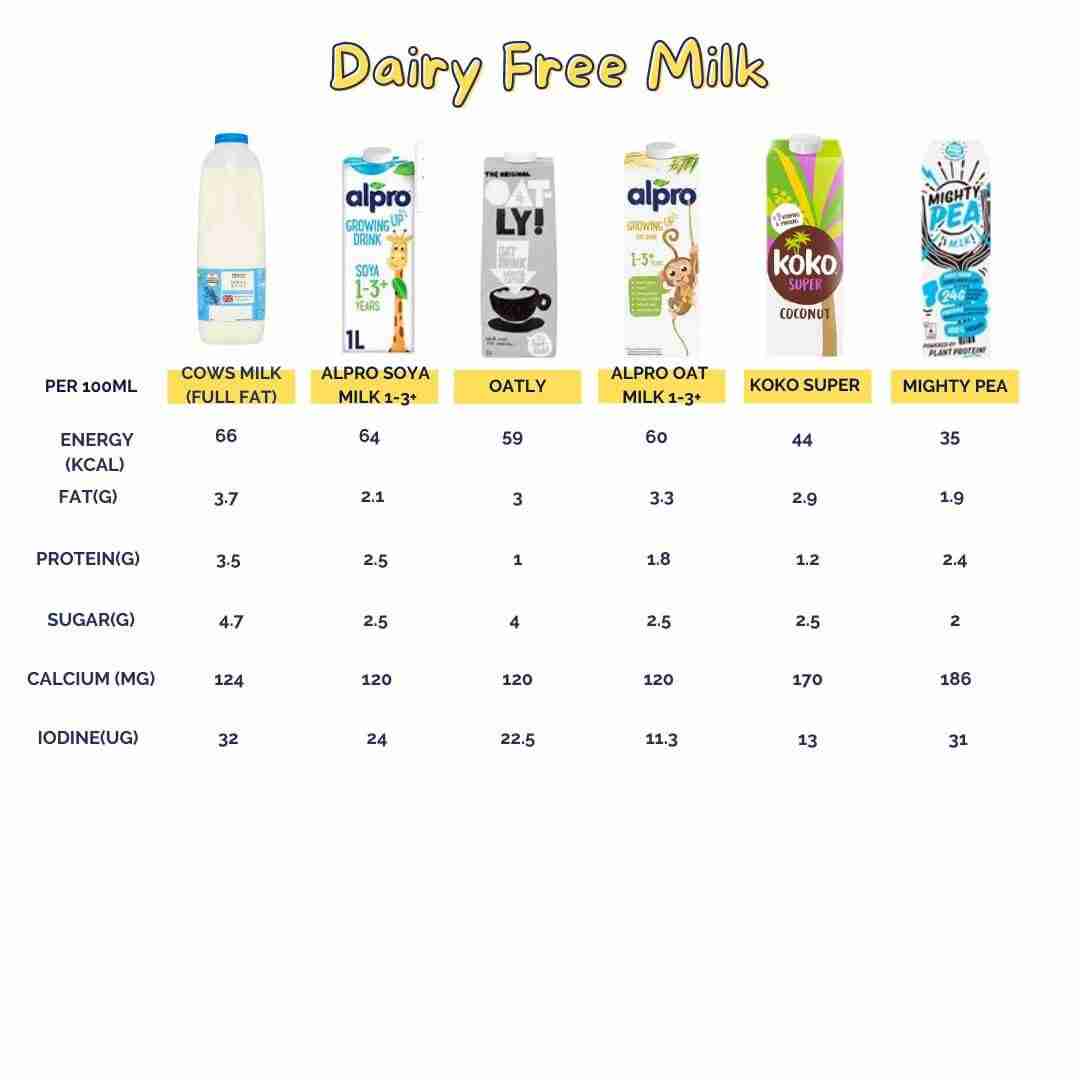
Yoghurt
Here are a few of my favourite dairy free yoghurts that are fortified. I recommend choosing the plain versions as they have less sugar and you can always have some finger food of fruit on the side.
- Koko Greek Yoghury (coconut based)
- Alpro Greek style (soya based)
- Oatly Oatgurt Greek style (oat based)
There are lots of other options out there as well. Just check the labels that are milk free and not just lactose free.
ADD IMAGE ON YOGHURTS
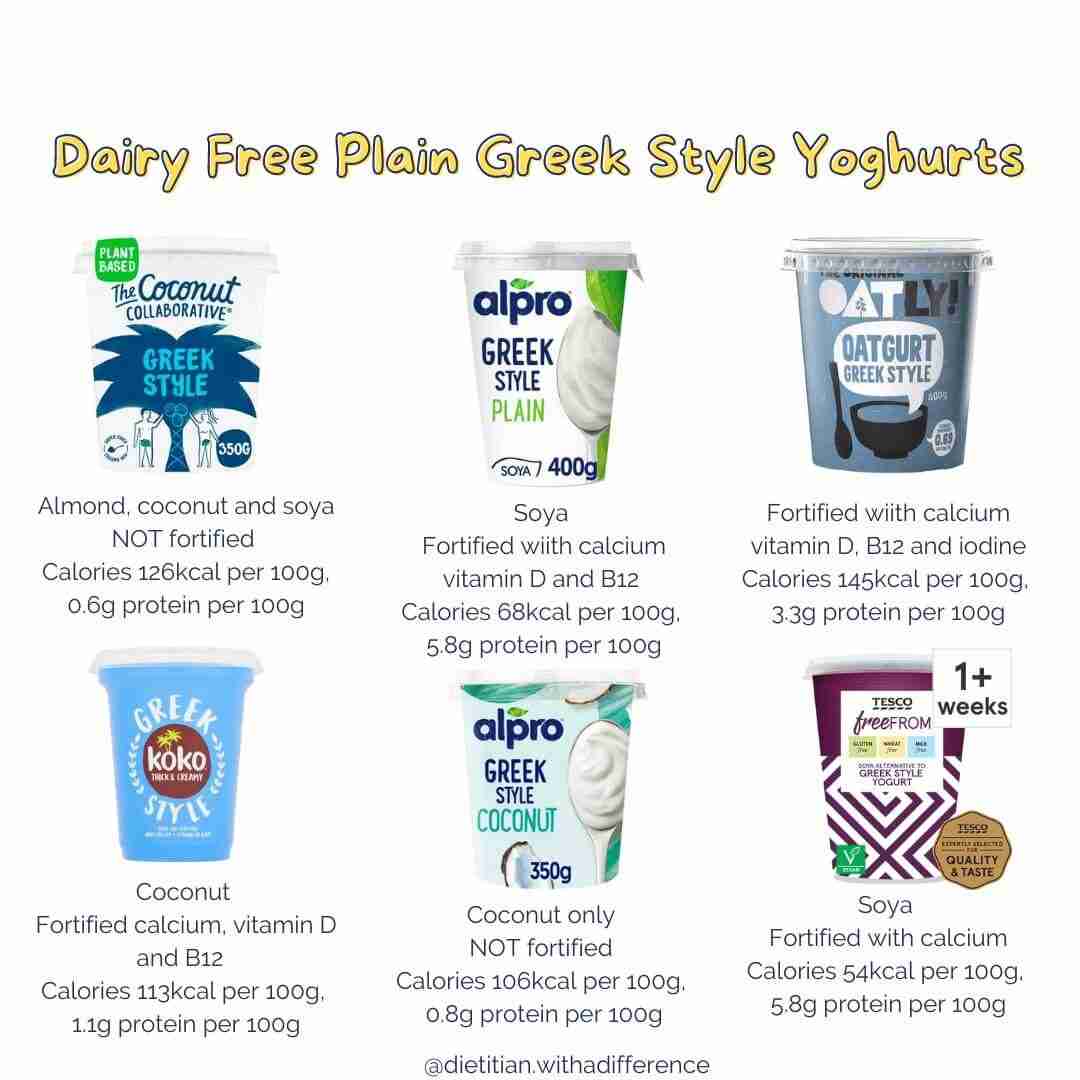
Cheese
I will be honest I struggled with dairy free cheese with my little girl who had a milk allergy. She really didn’t like dairy free cheese. However, there are many more options available now a days that six years ago. Here are just a few:
- Catherdral city plant based
- Violife epic mature
- Applewood creamy and smoky vegan minis
- Nush Chive cream cheese style spread
- Sheese Mature Cheddar style
Here is a review of the best diary free cheese according to BBC good food;
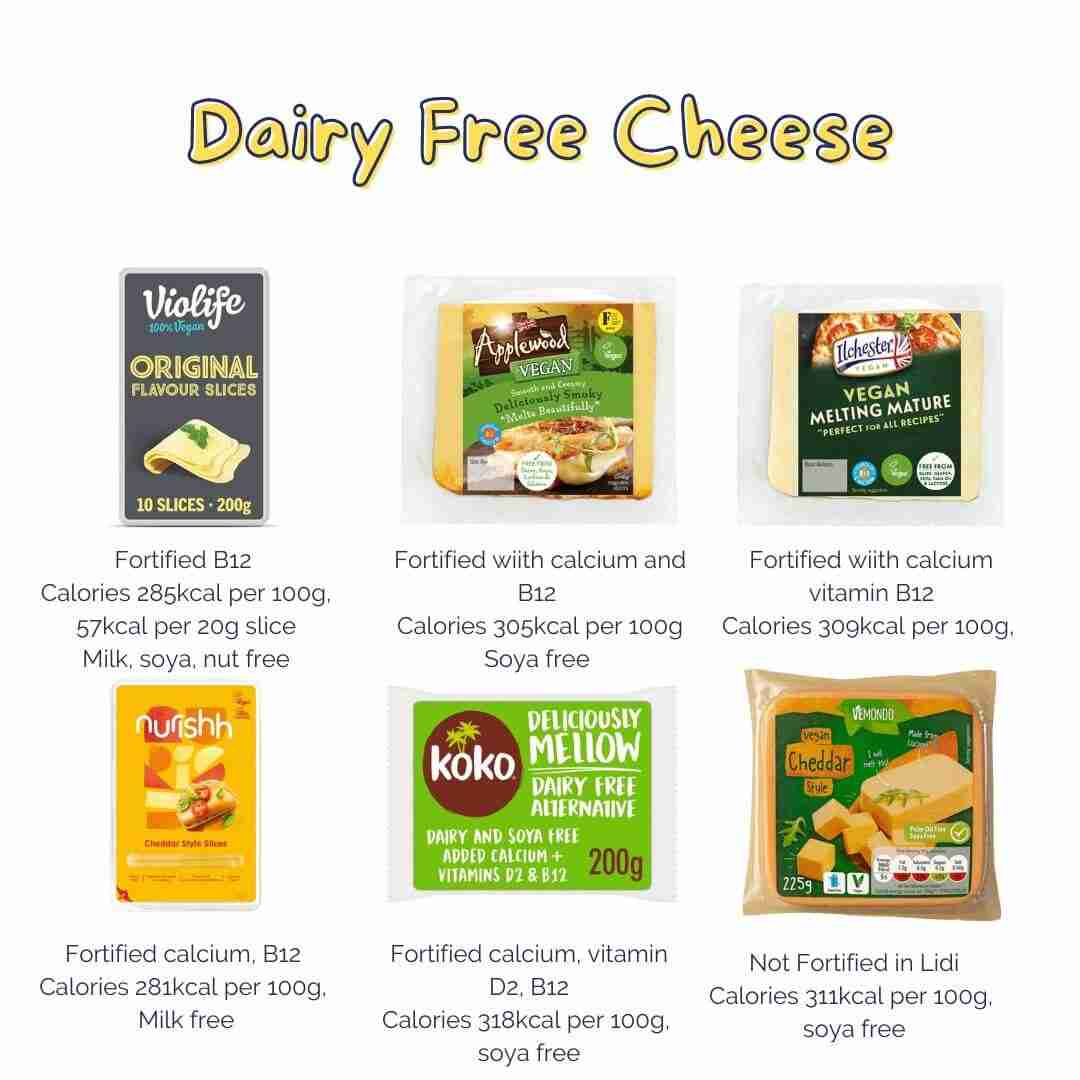
ADD IMAGE ON CHEESE
Dairy free weaning recipes
There are so many options available today and here are a few sites that are great for weaning recipes. Remember most recipes can be adapted to be milk free.
Based on personal experience, having lived through a milk allergy. I preferred oat milk for cooking with. But this is just my experience so have fun experimenting with your baby and your family. As no one wants to cook lots of different meals each night.
Here are a few of my favourite recipe sites:
- The Start for life website is full of useful weaning recipes for all ages and there are some good dairy free porridge recipes. As I always found breakfast challenging when we were dairy free.
- Another favourite of mine is BBC good food website
- Annabel Karmel also has milk free weaning recipes and I am sure if you are starting weaning you have come across her books.
- Or Download my free tips for dairy free weaning
Top tips for surviving dairy free weaning and beyond
Here are some tips for parents who are considering dairy-free weaning for their children:
- Consult with your child’s registered dietitian to ensure that your child is receiving all the necessary nutrients. To help you identify alternative sources of calcium, vitamin D, and other essential nutrients that are typically found in dairy products.
- To ensure that your child is receiving a balanced diet, it’s crucial to introduce a variety of fruits, vegetables, grains, and protein sources.
- Cross contamination and read labels: Many processed foods contain dairy products, so it’s essential to read the labels carefully when shopping. Look for dairy-free alternatives or try making your own versions of foods.
- Experiment with dairy-free alternatives: There are now plenty of dairy-free alternatives available in most supermarkets, including plant-based milks, cheeses, and yogurts. Experiment with different options to find the ones that your child enjoys the most.
My little girl’s favourite was Soya milk and even though she has outgrown her milk allergy she still refuses to have cow’s milk.
In conclusion, dairy-free weaning can still be enjoyable. It is important to work with your dietitian to introduce a variety of foods. But make sure you check all labels and experiment with dairy-free alternatives, that way you can ensure that your child receives all the necessary nutrients and has a balanced diet.
If you would like more support with dairy free weaning or a milk allergy book more help with a one to one package.
Written by Emma Shafqat, Paediatric Dietitian RD. The information is correct at the time of publishing the blog.



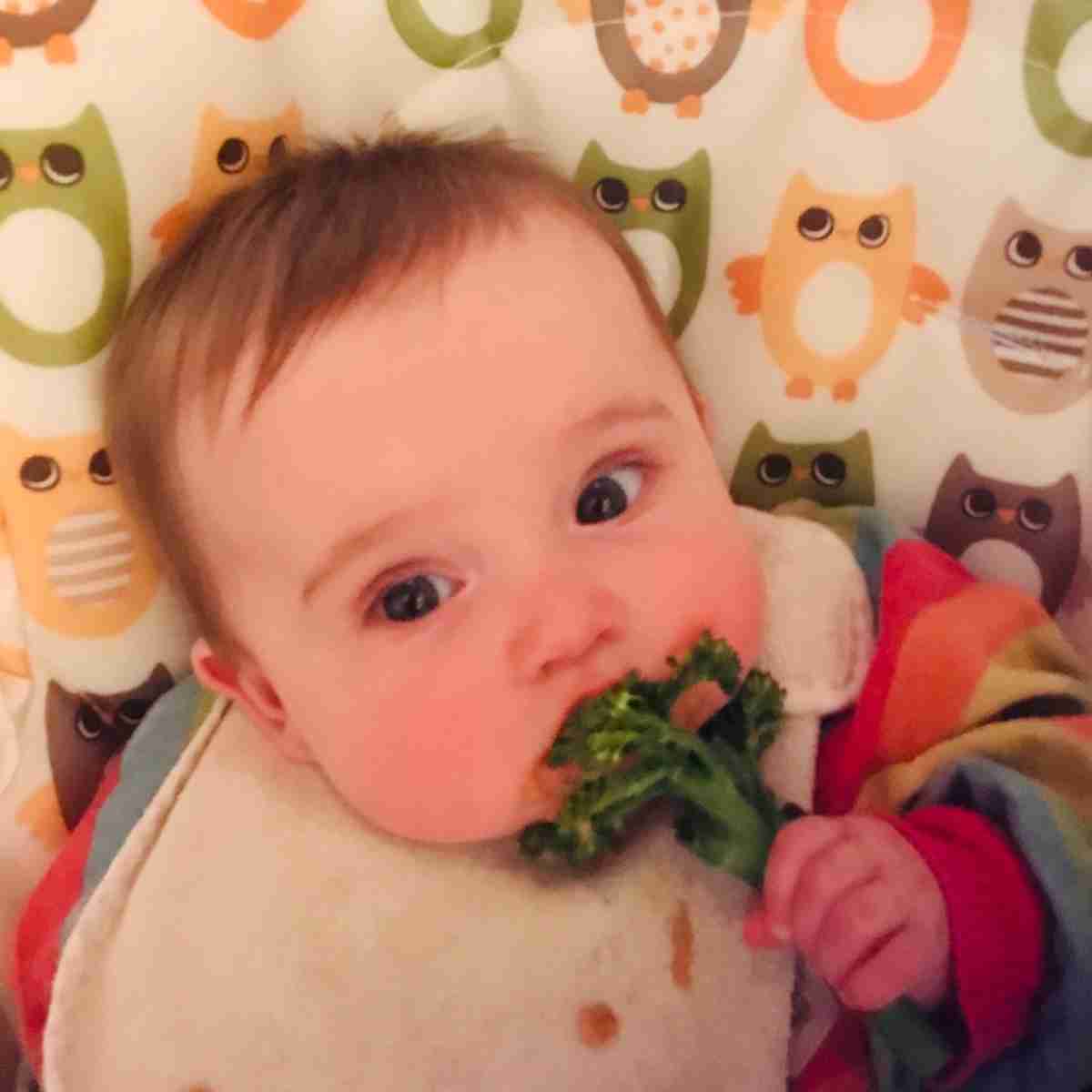

Such a helpful guide for parents dealing with cow’s milk allergy during weaning! I’m also finding the tips on https://www.shemed.co.uk super useful—makes the journey a bit easier. Thanks for sharing this!
Ensuring children receive the right nutrients when avoiding dairy is so important, and guidance from a registered dietitian makes a real difference. Understanding how different foods impact energy and blood sugar can also support balanced choices—this article on the glycaemic index is a helpful resource: https://www.shemed.co.uk/blog/understanding-the-glycaemic-index-gi-for-better-food-choices. Combining expert advice with nutritional knowledge builds a solid foundation for healthy eating.